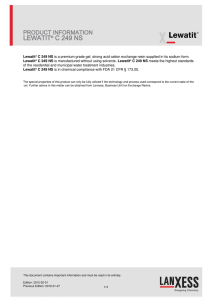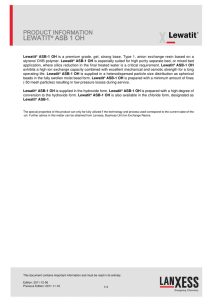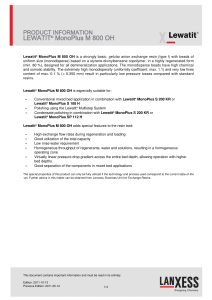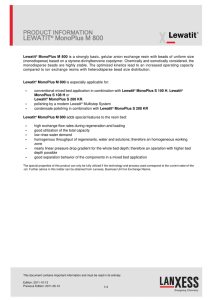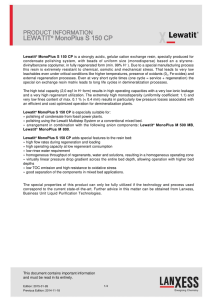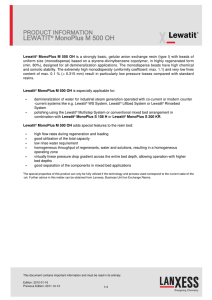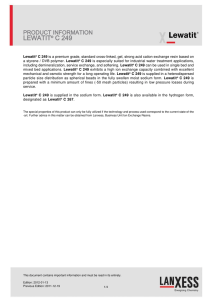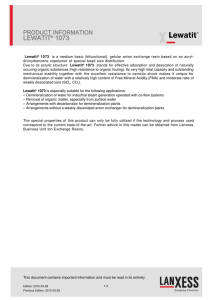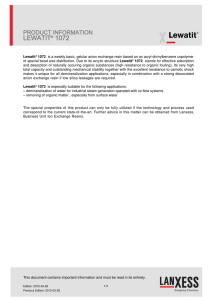uniform size (monodisperse) based on a styrene-divinylbenzene copolymer, designed for... demineralization applications. The monodisperse beads have high chemical and osmotic... Lewatit MonoPlus MP 600
advertisement
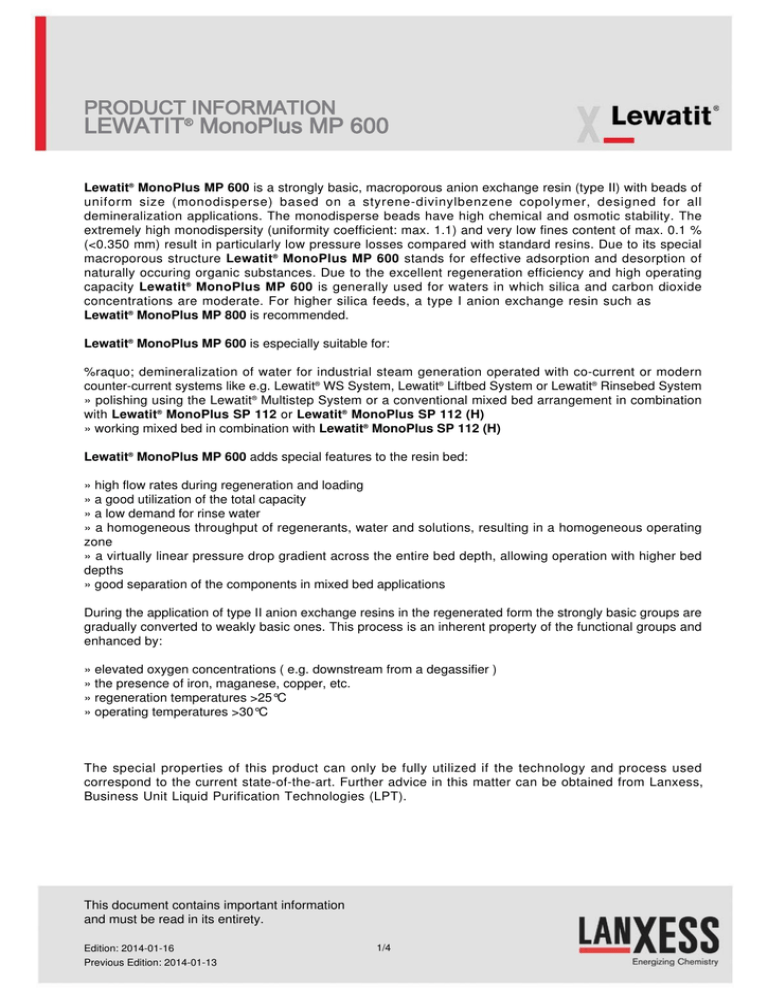
Lewatit® MonoPlus MP 600 is a strongly basic, macroporous anion exchange resin (type II) with beads of uniform size (monodisperse) based on a styrene-divinylbenzene copolymer, designed for all demineralization applications. The monodisperse beads have high chemical and osmotic stability. The extremely high monodispersity (uniformity coefficient: max. 1.1) and very low fines content of max. 0.1 % (<0.350 mm) result in particularly low pressure losses compared with standard resins. Due to its special macroporous structure Lewatit® MonoPlus MP 600 stands for effective adsorption and desorption of naturally occuring organic substances. Due to the excellent regeneration efficiency and high operating capacity Lewatit® MonoPlus MP 600 is generally used for waters in which silica and carbon dioxide concentrations are moderate. For higher silica feeds, a type I anion exchange resin such as Lewatit® MonoPlus MP 800 is recommended. Lewatit® MonoPlus MP 600 is especially suitable for: %raquo; demineralization of water for industrial steam generation operated with co-current or modern counter-current systems like e.g. Lewatit® WS System, Lewatit® Liftbed System or Lewatit® Rinsebed System » polishing using the Lewatit® Multistep System or a conventional mixed bed arrangement in combination with Lewatit® MonoPlus SP 112 or Lewatit® MonoPlus SP 112 (H) » working mixed bed in combination with Lewatit® MonoPlus SP 112 (H) Lewatit® MonoPlus MP 600 adds special features to the resin bed: » high flow rates during regeneration and loading » a good utilization of the total capacity » a low demand for rinse water » a homogeneous throughput of regenerants, water and solutions, resulting in a homogeneous operating zone » a virtually linear pressure drop gradient across the entire bed depth, allowing operation with higher bed depths » good separation of the components in mixed bed applications During the application of type II anion exchange resins in the regenerated form the strongly basic groups are gradually converted to weakly basic ones. This process is an inherent property of the functional groups and enhanced by: » elevated oxygen concentrations ( e.g. downstream from a degassifier ) » the presence of iron, maganese, copper, etc. » regeneration temperatures >25°C » operating temperatures >30°C The special properties of this product can only be fully utilized if the technology and process used correspond to the current state-of-the-art. Further advice in this matter can be obtained from Lanxess, Business Unit Liquid Purification Technologies (LPT). This document contains important information and must be read in its entirety. Edition: 2014-01-16 Previous Edition: 2014-01-13 1/4 General Description Ionic form as shipped Functional group Matrix Structure Appearance ClQuaternary amine, type II Crosslinked polystyrene Macroporous Beige, opaque Specified Data metric units max. mm min. eq/l Uniformity Coefficient Mean bead size Total capacity 1.1 0.6 (+/- 0.05) 1.1 Physical and Chemical Properties Bulk density Density Water retention Volume change Stability Storability Storability metric units g/l approx. g/ml wt. % max. vol. % (+/- 5 %) Cl- --> OHat pH-range of the product temperature range max. years °C This document contains important information and must be read in its entirety. Edition: 2014-01-16 Previous Edition: 2014-01-13 2/4 630 1.10 55 - 60 12 0 - 14 2 -20 - +40 Recommended Operating Conditions* metric units OPERATION Operating temperature Operating pH-range Bed depth Specific pressure drop Pressure drop Linear velocity REGENERATION, COUNTER-CURRENT Regenerant Regenerant Regenerant Linear velocity Linear velocity Rinse water requirement REGENERATION, COCURRENT Regenerant Regenerant Regenerant Linear velocity Linear velocity Linear velocity Rinse water requirement Bed expansion Freeboard max. °C (15 °C) operation type quantity concentration rinsing slow / fast type quantity concentration min. mm approx. kPa*h/m2 max. kPa max. m/h 30 0 - 12 800 1.0 300 50 approx. g/l approx. wt. % approx. m/h approx. m/h approx. BV NaOH 40 2-4 5 5 3.5 approx. g/l approx. wt. % approx. m/h approx. m/h approx. m/h approx. BV approx. % per m/h vol. % NaOH 100 3-5 5 10 5 7 11.5 100 backwash (20 °C) rinsing slow / fast backwash (20 °C) backwash (extern / intern) * The recommended operating conditions refer to the use of the product under normal operating conditions. It is based on tests in pilot plants and data obtained from industrial applications. However, additional data are needed to calculate the resin volumes required for ion exchange units. These data are to be found in our Technical Information Sheets. This document contains important information and must be read in its entirety. Edition: 2014-01-16 Previous Edition: 2014-01-13 3/4 Additional Information & Regulations Safety precautions Strong oxidants, e.g. nitric acid, can cause violent reactions if they come into contact with ion exchange resins. Toxicity The safety data sheet must be observed. It contains additional data on product description, transport, storage, handling, safety and ecology. Disposal In the European Community Ion exchange resins have to be disposed, according to the European waste nomenclature which can be accessed on the internet-site of the European Union. Storage It is recommended to store ion exchange resins at temperatures above the freezing point of water under roof in dry conditions without exposure to direct sunlight. If resin should become frozen, it should not be mechanically handled and left to thaw out gradually at ambient temperature. It must be completely thawed before handling or use. No attempt should be made to accelerate the thawing process. This information and our technical advice – whether verbal, in writing or by way of trials – are given in good faith but without warranty, and this also applies where proprietary rights of third parties are involved. Our advice does not release you from the obligation to check its validity and to test our products as to their suitability for the intended processes and uses. The application, use and processing of our products and the products manufactured by you on the basis of our technical advice are beyond our control and, therefore, entirely your own responsibility. Our products are sold in accordance with the current version of our General Conditions of Sale and Delivery. This document contains important information and must be read in its entirety. Edition: 2014-01-16 Previous Edition: 2014-01-13 4/4 Lenntech info@lenntech.com Tel. +31-152-610-900 www.lenntech.com Fax. +31-152-616-289
